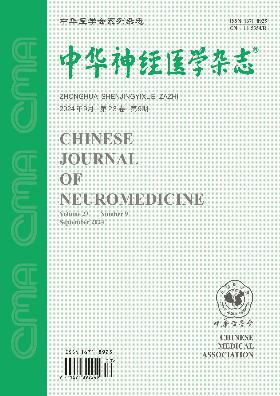Establishment of a nomogram model for risk of pulmonary infection after craniocerebral injury and preliminary assessment of its effectiveness
Q4 Medicine
引用次数: 1
Abstract
Objective To explore the risk factors of postoperative pulmonary infection in patients with craniocerebral injury and establish a nomogram model to predict the risk of postoperative pulmonary infection after craniocerebral injury. Methods The clinical data of 169 patients with craniocerebral injury, admitted to and underwent craniotomy in our hospital from January 2013 to December 2018, were retrospectively analyzed. The clinical data of patients with postoperative pulmonary infection and without postoperative pulmonary infection were compared. The risk factors of postoperative pulmonary infection were analyzed by multivariate Logistic regression. R language was used to establish a nomogram model to predict the risk of postoperative pulmonary infection after craniocerebral injury. Receiver operating characteristic (ROC) curve was used to explore the prediction efficiency of the nomogram model for pulmonary infection after craniocerebral injury. Results Among the 169 patients, 74 (43.8%) were complicated with pulmonary infection and 95 (56.2%) were not complicated with pulmonary infection. As compared with non-pulmonary infection group, pulmonary infection group had significantly higher percentages of patients with open craniocerebral injury and Glasgow coma scale (GCS) scores<7, significantly higher American Society of Anesthesiologists (ASA) grading, lower albumin level one week after surgery, statistically longer operation time, and significantly higher percentages of patients with conscious disorder, patients accepted intraoperative blood transfusion, patients used breathing machine, and patients stayed in bed for 4 weeks or more (P<0.05). Multivariate Logistic regression analysis showed that GCS scores (OR=0.243, 95%CI: 0.122-0.497, P=0.000), ASA grading (OR=3.349, 95%CI: 2.233-5.021, P=0.000), disturbance of consciousness (OR=3.185, 95%CI: 1.217-8.334, P=0.018), and use of ventilator (OR=3.376, 95%CI: 1.590-7.167, P=0.002) were independent risk factors for postoperative pulmonary infection in patients with craniocerebral injury. The scores of the nomogram model were 13.7, 100.0, 38.0 and 27.5 in GCS scores, ASA grading, disturbance of consciousness and use of ventilator, respectively. The consistency index of the nomogram model for predicting postoperative pulmonary infection in patients with craniocerebral injury was 0.835. ROC curve showed that the area under the curve predicted by nomogram model for postoperative pulmonary infection in patients with craniocranial injury was 0.840 (95%CI: 0.778-0.901). Conclusion Based on the risk factors for pulmonary infection after craniocerebral injury, a nomogram model for predicting the risk of pulmonary infection is established, which has a good differentiation degree and prediction effect, and can provide a reference for medical staff to identify high-risk patients at an early stage, so as to take more targeted intervention measures. Key words: Craniocerebral injury; Pulmonary infection; Nomogram; Risk factor颅脑损伤后肺部感染风险的nomogram模型的建立及其有效性初步评价
目的探讨颅脑损伤患者术后肺部感染的危险因素,建立预测颅脑损伤术后肺部感染风险的nomogram模型。方法回顾性分析2013年1月至2018年12月我院收治并行开颅手术的169例颅脑损伤患者的临床资料。比较术后肺部感染与无术后肺部感染患者的临床资料。采用多因素Logistic回归分析术后肺部感染的危险因素。采用R语言建立颅脑损伤后肺部感染风险的nomogram模型。采用受试者工作特征(ROC)曲线探讨nomogram模型对颅脑损伤后肺部感染的预测效果。结果169例患者中合并肺部感染74例(43.8%),未合并肺部感染95例(56.2%)。与非肺部感染组相比,肺部感染组开放性颅脑损伤患者比例和格拉斯哥昏迷评分(GCS) <7分明显高于美国麻醉学会(ASA)评分,术后1周白蛋白水平较低,手术时间较长,意识障碍患者、术中输血患者比例明显高于非肺部感染组。患者使用呼吸机,患者卧床4周及以上(P<0.05)。多因素Logistic回归分析显示,GCS评分(OR=0.243, 95%CI: 0.122 ~ 0.497, P=0.000)、ASA评分(OR=3.349, 95%CI: 2.233 ~ 5.021, P=0.000)、意识障碍(OR=3.185, 95%CI: 1.217 ~ 8.334, P=0.018)、使用呼吸机(OR=3.376, 95%CI: 1.590 ~ 7.167, P=0.002)是颅脑损伤患者术后肺部感染的独立危险因素。nomogram model在GCS评分、ASA评分、意识障碍和呼吸机使用方面的得分分别为13.7、100.0、38.0和27.5。预测颅脑损伤患者术后肺部感染的nomogram模型一致性指数为0.835。ROC曲线显示,nomogram模型预测颅脑损伤患者术后肺部感染的曲线下面积为0.840 (95%CI: 0.778 ~ 0.901)。结论基于颅脑损伤后肺部感染的危险因素,建立了预测肺部感染风险的nomogram模型,该模型具有良好的分化程度和预测效果,可为医护人员早期识别高危患者提供参考,从而采取更有针对性的干预措施。关键词:颅脑损伤;肺部感染;列线图;风险因素
本文章由计算机程序翻译,如有差异,请以英文原文为准。
求助全文
约1分钟内获得全文
求助全文
来源期刊

中华神经医学杂志
Psychology-Neuropsychology and Physiological Psychology
CiteScore
0.30
自引率
0.00%
发文量
6272
期刊介绍:
 求助内容:
求助内容: 应助结果提醒方式:
应助结果提醒方式:


